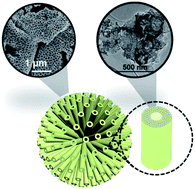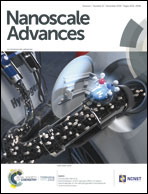3D defective graphenes with subnanometric porosity obtained by soft-templating following zeolite procedures†
Abstract
By applying the well-known templating mechanism employed for the synthesis of mesoporous silicas to the structuration of sodium alginate, a novel defective 3D tubular graphene material (graphenolite) with hierarchical macro/meso/micro-porous structure, very high powder specific surface area (1820 m2 g−1) and regular micropore size (0.6 nm) has been obtained. The key feature of the process is the filmogenic property of alginate that is able to replicate the liquid crystal rods formed by the CTAC template in the aqueous phase. The 3D graphene exhibits 2.5 times higher capacitance using Li+ electrolyte compared to K+, indicating that Li+ can ingress to the ultramicropores which, in contrast, are not accessible to K+. Electrochemical impedance measurements also indicate much lower resistance for Li+ in comparison to K+ electrolyte, confirming the benefits of controlled microporosity of 3D graphene granting selective access to Li+, but not to K+. The present report opens the door for the synthesis of a wide range of 3D graphene materials that could be prepared following similar strategies to those employed for the preparation of zeolites and periodic mesoporous aluminosilicates.



 Please wait while we load your content...
Please wait while we load your content...